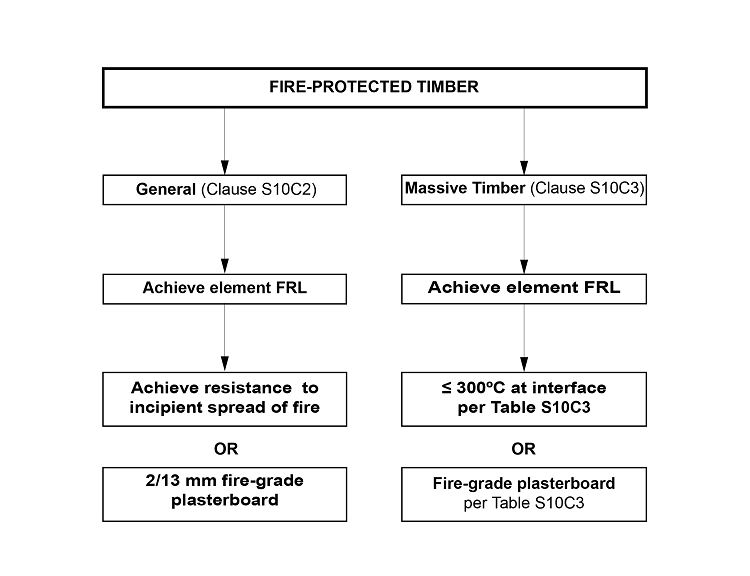NCC 2022 Volume One - Building Code of Australia Class 2 to 9 buildings
Search the National Construction Code editions
10
Specification 10 Fire-protected timberThis Specification contains requirements for fire-protected timber and procedures for determining the time at which the temperature at the interface between the protection system and the timber is exceeded.
To set out the requirements for fire-protected timber.
Specification 10 includes the requirements for fire-protected timber and procedures for determining the time at which the temperature at the interface between the protection system and a fire-protected timber element is exceeded.
To specify the protection requirements for fire-protected timber.
Where fire-protected timber is used, it must be provided with protection so as to achieve the FRL required of the building element.
In addition, the timber must have either of the following:
The covering required by S10C2(1)(b) may form part or all of the system used to protect the timber in order to achieve the required FRL of the building element.
S10C2(1)(b)(ii) separates the testing requirements into two sub-clauses: S10C2(1)(b)(i)(A) for horizontal elements and
(B) for other elements.
For testing of horizontal elements, the test must be conducted in accordance with Section 4 of AS 1530.4. The resistance to the incipient spread of fire is deemed to have failed at the time when the maximum temperature recorded by thermocouples located on the unexposed face of the element lining exceeds 250°C.
The requirements for the testing of other than horizontal elements are contained in S10C2(1)(b)(i)(B). For the purpose of measuring temperatures in accordance with this clause, thermocouples complying with clause 2.2.3.1 of AS 1530.4 shall be positioned at the following locations:
For wall systems and the like:
The testing must be carried out in accordance with the Standard Fire Test, or an equivalent or more severe test on the timber element with the proposed non-combustible fire-protective covering fixed in a representative manner and confirmed in a report from an Accredited Testing Laboratory.
Figure S10C2
Fire-protected timber.

| Application | Time – without timber interface exceeding 300°C (mins) | Minimum thickness of fire-grade plasterboard (mm) |
|---|---|---|
| Inside a fire-isolated stairway or lift shaft | 20 | 13 |
| External walls within 1 m of an allotment boundary or 2 m of a building on the same allotment | 45 | 2 x 13 |
| All other applications | 30 | 16 |
To specify alternative protection requirements for fire-protected timber which is massive timber.
Fire-protected timber which is massive timber need not comply with S10C2 if it complies with S10C3. Compliance with S10C3 is achieved when all of the following is applied:
The covering required by S10C3(1)(b) may form part or all of the system used to protect the timber in order to achieve the required FRL of the building element.
The option provided under S10C3(1)(b)(i) requires a test to be carried out on a representative specimen. Refer to S10C4, S10C5 and S10C6 for test procedures.
Under S10C3(1)(c) the fire-protective covering may be fixed to timber battens so long as any cavities are filled with non- combustible insulation.
Determination of time the timber interface temperature exceeds 300°C for timber at least 75 mm thick.
To provide a test procedure for massive timber.
S10C4 specifies the testing requirements for fire-protected timber. S10C4(1) requires the test to be in accordance with the Standard Fire Test, or to apply an equivalent or more severe test method. The Accredited Testing Laboratory must also provide a report to confirm the time at which the timber interface temperature exceeded 300°C.
The remaining sub-clauses are specific requirements on how to conduct the test. S10C4(2) requires the test specimen to incorporate representative joints used in the proposed system. The locations where interface temperatures are measured during the test is specified by S10C4(3). The final sub-clause, S10C4(4), specifies the method of measuring the temperature; which is in accordance with AS 1530.4.
An Accredited Testing Laboratory may carry out the test specified in S10C4 at pilot scale provided—
To allow a smaller test specimen to be tested.
S10C5 permits the Accredited Testing Laboratory to conduct a test using a smaller test sample than that required by S10C4, provided:
The time the timber interface temperature exceeds 300°C must be taken as the minimum time any of the thermocouples specified in S10C4 exceeded 300°C.